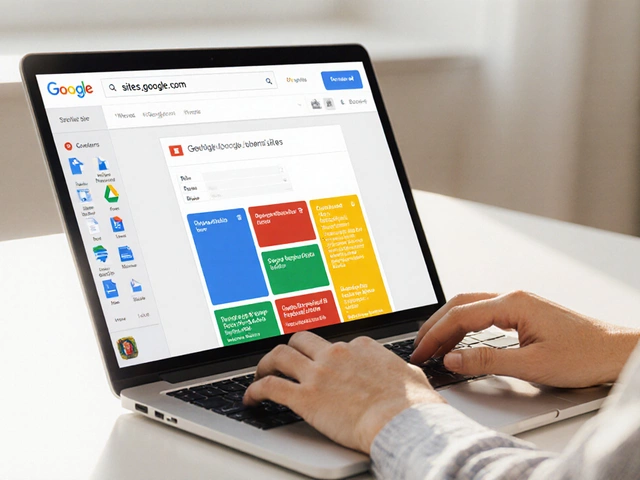Stepping into the world of blogging can feel like embarking on a thrilling adventure where creativity knows no bounds. You're eager and teeming with ideas, but a question looming large is: How many articles should you have ready before launching? This isn't just a numbers game, but a strategic move towards making an impactful entry.
An enticing blog doesn't just showcase quantity; it embraces the magnetic pull of quality content tailored to engage and captivate readers. Knowing the right balance is crucial. With just the right tools and strategies, setting up a compelling blog can actually be more straightforward than it seems.
- Initial Article Count
- Engaging Your Audience Immediately
- Tools and Platforms for Blogging
- Quality vs Quantity in Blog Posts
- Consistency and Growth
Initial Article Count
The number of articles you should have in your blog’s arsenal before launching is a pivotal decision, setting the tone for your budding online presence. While there's no magic number that fits all, seasoned bloggers suggest having at least 10 to 15 posts ready to go. This initial burst of content helps create the impression of an established blog, enticing visitors to linger longer and explore what you have to offer. The idea is to strike a delicate balance, ensuring your blog opens its doors with a variety of content formats and topics to cater to diverse reader interests. From tutorials, opinion pieces, to lifestyle articles, having a diversified starting lineup caters to a broader audience.
Creating these initial posts also serves another purpose; it provides you, the writer, with a clear sense of your blog’s identity and voice. During this phase, you’ll refine your style, experiment with different post structures, and hone in on what resonates best with your target audience. An interesting fact to consider, blogging experts from HubSpot found that companies that update their blog 16 or more times a month draw in 3.5 times more traffic than those that publish four or fewer posts each month. This finding is a strong reminder of the importance of having a solid collection of articles to begin with to boost initial visibility and engagement.
Having a robust set of articles doesn’t just sit well with readers; it plays a crucial role with search engines too. A well-populated blog increases your chances of ranking for a variety of keywords, thus improving visibility on search engines like Google. By having an array of articles, you enhance your blog’s ability to tap into different search queries, which can significantly widen your audience reach. Consider it an opportunity to incorporate strategic keywords, ensuring your content is optimized for discoverability. These keywords must flow naturally within engaging stories and offer value to your audience.
Let’s take a more analytical approach to understand this strategy. Look at the diverse needs of your audience and structure your initial post lineup to serve these needs effectively. For instance, an instructional or how-to post might captivate one section of your audience, while an entertaining personal anecdote pulls in another. Having a breadth of content prevents your blog from feeling like a one-trick pony. In doing so, each new visitor has a higher chance of finding something relevant that speaks directly to them, increasing the chances of return visits and recommendations.
As renowned blogger Darren Rowse once noted, "A blog is only as interesting as the interest shown in others." This quote succinctly underscores the essence of prioritizing engagement through diverse content that appeals to your readers' varied tastes.
A compelling beginning should also account for reader retention. By preparing enough content ahead of time, you can schedule posts for regular publication without the pressure of creating new content amidst the hustle of launching. This practice establishes consistency which is key in retaining reader interest and fostering loyal followers. Ultimately, starting a blog with a well-thought-out count of initial articles is a strategic key to unlocking long-term success, enabling you to build momentum from the very first day.
Engaging Your Audience Immediately
Starting strong with your blog means creating a sense of connection with your readers right out the gate. Engaging your audience immediately isn't just about having content, it’s about crafting an inviting space where your voice resonates with them across glowing screens. Capturing attention within an instant is more crucial now than ever, as digital spaces are teeming with content vying for every reader's eyes. Begin by understanding your core audience—their needs, desires, and the questions they seek to have answered. This insight should seep through each piece you compose, making your blog a destination rather than a detour. Ensure that every post doesn't just provide information, but tells a story, invites curiosity, and encourages interaction.
Start with an inviting headline, one that reflects an air of intrigue or promises a solution. The first few lines of your article are golden; make your readers feel understood. It’s not enough to state facts; you need to weave them into narratives that prompt your audience to care. A clever strategy is embedding questions within your content that mirror your audience's internal queries, thus creating a dialogue-like atmosphere. You might even consider leaving certain inquisitive gaps that challenge readers to think beyond just the content provided. For new blogs, the design and user experience also play vital roles. Your layout should seamlessly guide visitors across topics, highlighting your most impactful messages. Visual elements complement your words, breaking the monotony and enhancing comprehension with images or infographics. This is supported by research, which suggests that 65% of people are visual learners, meaning they grasp and retain information better when it's presented with accompanying images or fireworks of color.
Interactions also foster engagement. Allowing comments on your blog can bring life to your virtual writing desk. Responding to comments can make your audience feel seen, and their opinions valued, prompting them to return for future posts. Another gateway to engage visitors often is through social media channels. Share snippets of your articles across platforms to captivate a broader audience and lure them back to your blog. Don’t miss out on harnessing the power of SEO. Utilize strong keywords not just to pander to algorithms, but in a way that naturally fits into your content's narrative. Launch contests or giveaways for a bit of fun engagement; these not only expand your reach but build a community around your blog.
Creating listicles or how-to guides can lend structure to your posts, making them digestible and action-oriented. Consider a feedback loop where users can rate posts or suggest future topics, actively involving them in the blog's growth. Remember that blogs thriving with dynamic content—ranging from written articles to podcasts or video series—tend to maintain higher engagement levels. As said by author Brian Tracy, "Communication is a skill that you can learn. It's like riding a bicycle or typing. If you're willing to work at it, you can rapidly improve the quality of every part of your life." Investing in enhancing your communicative abilities can be a game changer in keeping your readers engaged and enthused.

Tools and Platforms for Blogging
Choosing the right tools and platforms for your blogging journey can feel like picking the perfect canvas for your creative masterpiece. With a plethora of options available, it's crucial to find a home for your ideas that matches your style and objectives. Whether you're looking to dive into blogging as a hobby or a business, understanding how to navigate the landscape of digital resources is a game-changer.
WordPress stands tall in the blogosphere, beloved by many for its flexibility and vast array of plugins that help customize your site's functionality. It's been reported that over 40% of global websites use WordPress (source: W3Techs), making it a tried-and-tested giant in the field. It offers both a .com version, which is hosted and beginner-friendly, and a .org version, allowing you full control and hosting choice. This dual offering helps cater to both the novice blogger and the seasoned pro looking to have every detail under their thumb. If WordPress feels too robust, Shopify and Squarespace provide more streamlined, intuitive solutions, focusing more on aesthetics and ease of use for those who value simplicity and design.
For bloggers keen on capturing audiences on the go, platforms like Medium and Substack offer unique opportunities. They aren't just about providing a space to write; they're about cultivating a community. Medium allows you to engage readers directly linked by interests, while Substack is carving out a niche for writers to build a dedicated subscription base. As Ev Williams, co-founder of Medium, once said:
"The internet is too big. It's made of too many disparate parts. With Medium, we want to build something better."This sentiment rings true in the way Medium and Substack strive to offer a meaningful connection between writer and reader.
Delve into Google's own Blogger for a no-fuss, cost-free blogging experience. It's generally favored by those who appreciate Google's ecosystem and seamless integration with its other services. However, assistance does come in many forms beyond just platforms. SEO tools such as Yoast, which integrates seamlessly with WordPress, can propel your content to the top of search results, optimizing for the very heart of blog content the world craves.
Analyzing data and understanding how your articles perform are also critical aspects you shouldn't overlook. Platforms like Google Analytics and Jetpack help you track your blog's reach and reader behavior. They provide insights that allow you to finetune your strategy, understand what resonates with your audience, and continually improve your blog. Adopting these digital tools and platforms not only equips you with the necessary infrastructure but also inspires confidence to grow and sustain your presence in the vast ocean of the internet.
Quality vs Quantity in Blog Posts
As you embark on your blogging journey, a common dilemma is whether to focus on quantity or quality when creating content. Aspiring bloggers often debate how many articles are necessary to capture an audience's attention and establish a strong presence in the vast, bustling digital world. It's tempting to churn out as many posts as possible to keep the blog bustling with activity. Yet, the true magic lies in crafting well-researched, engaging, and valuable content that resonates with readers. Consider a blog as your platform to communicate effectively with an audience that seeks authenticity and originality.
Cutting through the noise means offering not just information but insights that captivate the mind and heart. A profound piece that showcases unique insights and gives solutions to readers' problems can significantly increase audience engagement, loyalty, and trust. Neil Patel, a renowned digital marketing guru, once said, "Focusing on quality makes sense because ultimately, you want to encourage your readers to keep coming back to your blog."
Balancing both quality and quantity requires a thoughtful strategy. It involves understanding your audience's needs, researching thoroughly, and spending considerable time crafting each piece with care. By dedicating effort to crafting fewer, high-quality blog pieces, you showcase professionalism and respect for your audience's time, which is imperative in the blogging realm. Explore popular blogs in your niche; you'll notice the ones that capture significant attention often prioritize substance over sheer volume.
Blog content is not merely about writing for the sake of it; it's about creating value. But how many articles should you launch with to optimize both quality and quantity? A good rule of thumb is to have at least five to ten well-crafted pieces when starting. This gives readers enough material to browse, explore, and get a feel for the themes and style of your writing. These initial posts should cover a variety of topics within your niche, showcasing the scope of your expertise while ensuring that the content is original, informative, and offers fresh perspectives.
An often overlooked aspect is the role of adapting and updating content. As time goes on, you might find older posts that could benefit from an update or a fresh spin. Keeping content timely and relevant is part of focusing on quality, ensuring the information you provide holds current value and accuracy. This approach can help you maintain the blog's relevance and credibility, nurturing a reader base that anticipates your next insightful post.

Consistency and Growth
There's a saying among seasoned bloggers: consistency builds trust, and trust builds audience. At the heart of growing a successful blog lies the secret of consistent, high-quality content production. This rings especially true in the bustling world of blogging, where maintaining a regular posting schedule is as crucial as the content itself. Having a content calendar can aid immensely in achieving this consistency. Such a tool helps plan, organize, and schedule posts in advance, ensuring you meet reader expectations reliably. The captivating allure of knowing when your next dose of insightful content is due can keep audiences returning, fostering a loyal community eager for each new post.
Moreover, consistent posting encourages better engagement, both from readers and even from search engines like Google. This regularity pushes your blog content into the digital limelight, increasing visibility and potentially landing you first-page real estate in search results. Indeed, platforms like WordPress or Blogger offer built-in planners that make this undertaking less arduous, transforming an overwhelming task into manageable small steps. Additionally, tools like Google's Search Console provide invaluable feedback on how often your posts are crawled and indexed, giving you insights into improving your posting frequency for optimal growth while maintaining quality.
As you nurture your blog, it's worthwhile to consider a balanced mixture of evergreen and timely posts. While evergreen content, which remains relevant for long periods, ensures sustained search traffic, timely posts that delve into current trends can attract a temporary surge in interest. A dependable rotation between these two can enhance both the short-term and long-term growth of your site. Articles for blog that captivate both new and returning readers ultimately become the cornerstone of a thriving blog. As Jay Baer, a noted digital marketing expert, says,
"The best content doesn’t win. The best-promoted content wins."It’s crucial to not just produce content consistently but also consistently promote it across social media channels, newsletters, or through collaborations with other bloggers to maximize reach.



